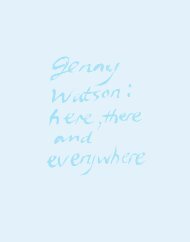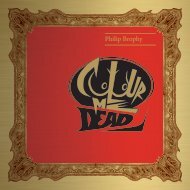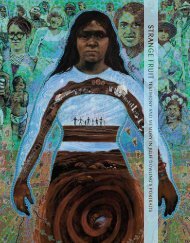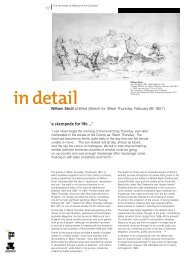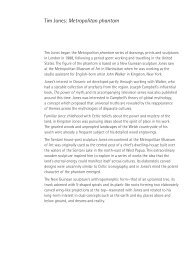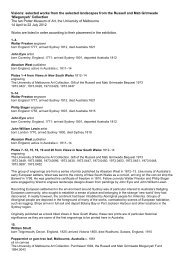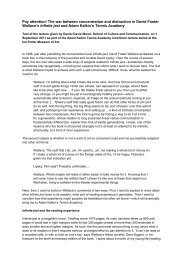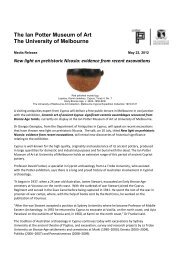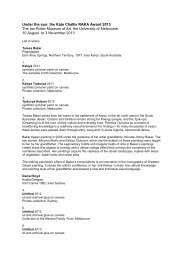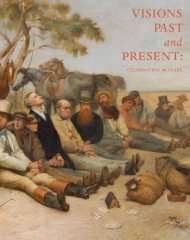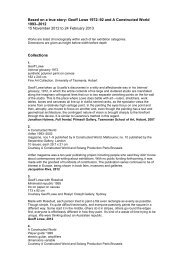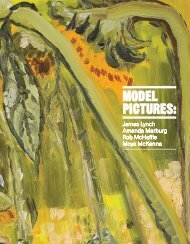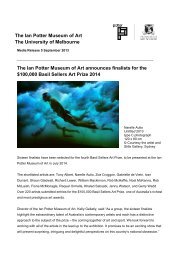The drowned world Jon Cattapan works and collaborations
Catalogue - Ian Potter Museum of Art - University of Melbourne
Catalogue - Ian Potter Museum of Art - University of Melbourne
- No tags were found...
Create successful ePaper yourself
Turn your PDF publications into a flip-book with our unique Google optimized e-Paper software.
<strong>Cattapan</strong>: <strong>The</strong> fold [2000] was a transitional picture. I<br />
hadn’t made a painting with a couple of big figures in it for<br />
maybe ten or so years so it was a pretty bold kind of step.<br />
I wanted to have a go at something very different, a really<br />
simple idea. It’s based on a very tiny image of two<br />
footballers tackling, from the sports pages of <strong>The</strong> Age.<br />
It’s been blown up until what you see are the colour<br />
separations of the printing process. I’ve tried to make<br />
a figurative picture applying the logic of some of my<br />
cityscape paintings where there’s a mapping of the figure<br />
over the top. It kind of dovetails with Aboriginal art:<br />
although you’re looking at two figures, you’re also looking<br />
at a kind of topography <strong>and</strong> a kind of mapping.<br />
Burns: I think it’s an incredibly successful painting. It’s a<br />
unified picture plane. All of these things that you’ve<br />
separated out into different surfaces have come together<br />
<strong>and</strong> been worked on the same plane. <strong>The</strong> transition from<br />
the abstract language to figuration means the differences<br />
between the two are minimised.<br />
Healy: I reckon it’s a transitional painting because it takes<br />
some of the violence that’s really central to <strong>Jon</strong>’s work, puts<br />
it together with an abstracted version of the cityscapes,<br />
makes some references in the bottom quarter to l<strong>and</strong>scape<br />
in colour <strong>and</strong> then connects it to a different sense of<br />
l<strong>and</strong>scaping in the dotting at the top, which I think is<br />
actually quite distinctive <strong>and</strong> new. So I think it’s an<br />
in-between painting in a very positive sense.<br />
Burns: I don’t read it as violent.<br />
Healy: I do.<br />
Burns: It could be an amorous act as well.<br />
Healy: Water is very consistent in the <strong>works</strong>. One of the<br />
curious connections between the drawings <strong>and</strong> the<br />
paintings is that the drawings—watercolours—often evolve<br />
through the malleability of watery paints into a wateriness<br />
in the paintings. It’s evolved through a different medium<br />
but there’s still a sense of how your body feels around<br />
water or in water or on water.<br />
<strong>Cattapan</strong>: <strong>The</strong> metaphor of <strong>The</strong> city submerged was<br />
about things dissolving, just the territory surrounding<br />
you dissolving.<br />
Nicholson: It’s connected to the nocturnal as well, isn’t it?<br />
Because the nature of darkness is that you float in it; there’s<br />
some connection between the appearance of water <strong>and</strong><br />
the sensation of being in darkness.<br />
Healy: Yes, but it’s also <strong>Jon</strong>’s take on modernity. I mean<br />
Marx talked about modernity as a <strong>world</strong> in which all that’s<br />
solid melts into air. So it’s about a melting version of<br />
modernity. Zygmunt Baumann calls it ‘liquid modernity’;<br />
he talks of postmodernity not being really after modernity<br />
but as liquid modernity. <strong>Jon</strong>’s recognising this in an<br />
artistic sense.<br />
Dr Karen Burns is an art critic <strong>and</strong> historian who teaches at the University<br />
of Melbourne. She has researched <strong>and</strong> published extensively on architecture<br />
<strong>and</strong> urban tourism.<br />
Dr Chris Healy teaches cultural studies at the University of Melbourne<br />
<strong>and</strong> recently stepped down as co-editor of Cultural Studies Review<br />
. His books include From the ruins of<br />
colonialism: History as social memory (1997), South Pacific museums<br />
(2006) <strong>and</strong> the forthcoming Forgetting Aborigines.<br />
Tom Nicholson is a Melbourne artist. Most recently, his work has been<br />
included in <strong>The</strong> body. <strong>The</strong> ruin (the Ian Potter Museum of Art)<br />
<strong>and</strong> Ghosts of self <strong>and</strong> state (Monash University Museum of Art).<br />
We are grateful to Peter Daverington for recording <strong>and</strong> photographing<br />
the conversation.<br />
18



